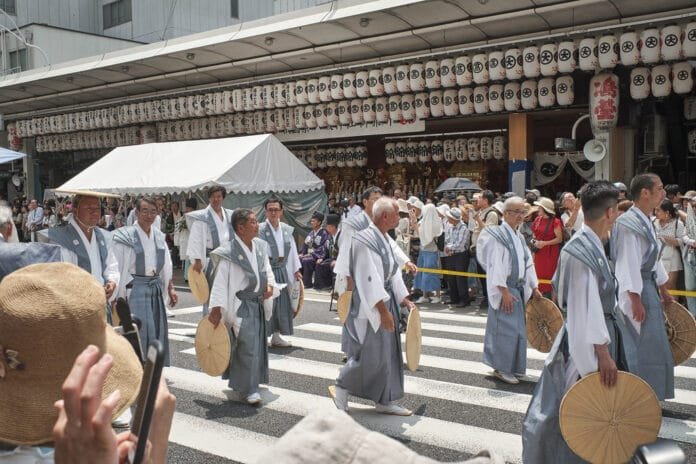
Today, Osaka is one of Japan’s most populous cities. Indeed, it was a central location in early Japanese civilisation, as political power was originally consolidated in the Kansai region, comprising modern-day Osaka, Kyoto, Kobe and the surrounding area. Several of Japan’s early capitals were located in what is now Osaka City and Osaka Prefecture. Since that time, Osaka has continued to be among Japan’s largest and most important cities. It has grown and developed, playing key roles throughout Japanese history and finally becoming the centre of culture and commerce we can recognize today. Osaka has millions of residents, and many more people live in nearby Kyoto, Kobe and the towns and cities between. The goal of this essay is to look at the social history of these people, in order to paint a picture of how and why Osaka, its people and its institutions have come to be. With that in mind, the starting point will be a general overview of Osaka’s geography and historical development as a city, including some details about housing, population changes and natural disasters. From there, there will be further discussion of Osaka’s demographics, including minority groups and the issues they face; the religious history of Osaka and popular festivals; and the development of educational institutions including universities. history of Osaka
Table of Contents
Osaka’s birth and growth
Osaka City comprises an area of 225 km2.[1] Osaka Bay, to the west, is connected to the Seto Inland Sea, which provides routes between different islands of Japan. Major rivers such as the Yodo River (or Yodogawa) flow through the city into Osaka Bay. To the north, south and east are the other cities which make up Osaka Prefecture, as well as Amagasaki in Hyogo Prefecture to the northwest. Nearer the edges of the prefecture are mountainous areas including the Kongo Range in the south and the Hokusetsu Mountains in the north. The city of Osaka was designated as such in the late 19th century, but originally this covered only the very centre, and it has since expanded to its current area. The prefecture, too, has grown in size: when modern prefectures were founded in the mid-19th century, Osaka was the smallest, but land reclamation in Osaka Bay, in particular the development of Kansai International Airport on an artificial island in the 1990s, allowed Osaka to overtake Kagawa Prefecture in area.[2]
In the distant past, much of what is now Osaka was underwater.[3] Osaka Bay reached further east, as far as around where Osaka Castle now stands. In Japanese prehistory, this landmass – the Uemachi Plateau – was a peninsula connected to land to the south, and to its east was Kawachi Bay, a body of water covering a great deal of modern Osaka Prefecture. Over time, this bay was separated from Osaka Bay and became Kawachi Lake during the Yayoi Period, an era beginning in 500 BCE or earlier and lasting until around 300 CE; it was later filled in, becoming a swampy plain.[4] The result of these changes was a damp area criss-crossed with rivers, ideal for the cultivation of rice, which is thought to have begun in Japan in the Yayoi Period. The Osaka area was therefore crucial to agriculture and also to growing international exchange during the following Yamato Period, when clans in the area now corresponding to neighbouring Nara Prefecture consolidated their authority. At this time, civil engineering projects diverted rivers, excavated canals and built roads to increase the interconnectedness of settlements in the Osaka area including Naniwa-zu port and Sakai, and to link them with Yamato.[5] Later in history, further projects served to rein in the perennial issue of flooding, as well as to enable greater movement between Osaka and Kyoto – where the capital of Japan was situated throughout the mediaeval era – and for strategic benefit.
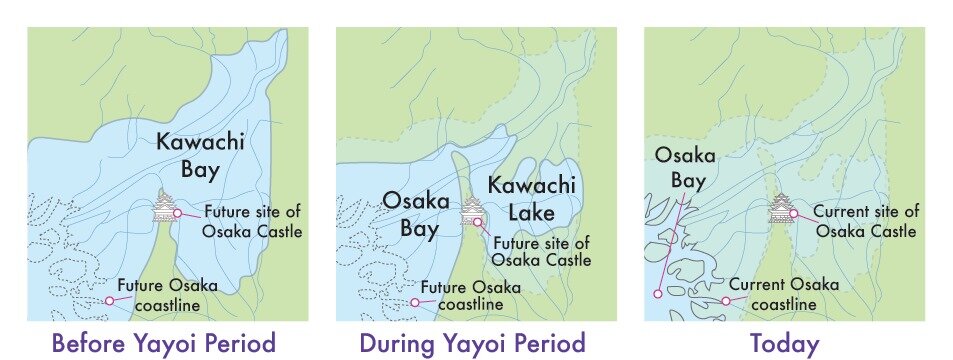
It is difficult to determine precisely how people lived in early Japan, as the first written histories did not appear until around the 6th century CE, and the priority of these chronicles was not to record the daily habits of the common people but to vindicate the position of the new imperial rulers.[6] This means that most of what we know is based on archaeological evidence. Some important archaeological sites that exist in and around Osaka include kofun, mounds usually in the shape of keyholes, which entombed members of the imperial class. Though kofun exist all over Japan, including surprisingly far-flung areas, Osaka Prefecture is home to arguably the most significant of these: the Mozu-Furuichi group, inscribed in 2019 as a UNESCO World Heritage Site.[7] Among the Mozu-Furuichi group is the enormous Daisenryo Kofun, traditionally regarded as the final resting place of Emperor Nintoku in the 5th century. Other archaeological evidence from this period includes pottery and the remains of dwellings, which were the same kind of thatched pit houses that existed in prehistory.[8] However, in keeping with the establishment of a political authority at this time, there is also evidence that there was a new social hierarchy where people of different classes were clearly separated, and those in stronger positions lived in relative luxury. Osaka Prefecture is home to examples of these dwellings, including the sites of homesteads (or yashiki-chi).[9] The significance of these sites is that they show farmers could build and rebuild independently, and pass the home on to their descendants, thus developing concepts of permanent homes and family.
Although the Osaka area remained a populated region in the eras that followed, its political significance declined. The capital, which in early Japanese history moved frequently, including to parts of modern Osaka on more than one occasion, was shifted permanently to Kyoto in the late 8th century, and the elite class and associated culture flourished there, rather than in Osaka. After centuries of political upheaval during which the samurai warrior class gained political authority, Osaka became significant once again – and first became known as Osaka – during the Edo Period, when Japan was at relative peace. This peace was achieved in part by the efforts of Toyotomi Hideyoshi, who founded Osaka Castle in the late 16th century. The castle later fell to the forces of Tokugawa Ieyasu in the Siege of Osaka, putting an end to a potential threat to Tokugawa’s leadership and enabling the peaceful period that followed.[10] One crucial development attributed to Toyotomi, which then continued throughout Tokugawa’s reign and the rest of the Edo Period, was reform of the class system.[11] Under this system, based on the Four Occupations of Confucian thought, there were ostensibly four castes: samurai, then farmers and peasants, then artisans, and finally merchants.[12] These social positions were hereditary, and determined where one would live and how one should behave; they were also rigidly distinct and people were not allowed to move between them or intermarry. In addition to these four castes, there were other groups above and below. At the top were the emperor who was a national figurehead, the shogun who was the ruler in practice, and priests and monks. Beneath the four classes were outcaste groups called eta and hinin, who worked in professions considered taboo. This class system persisted for hundreds of years, but before coming to an end in the 19th century, it had already been unravelling for some time.
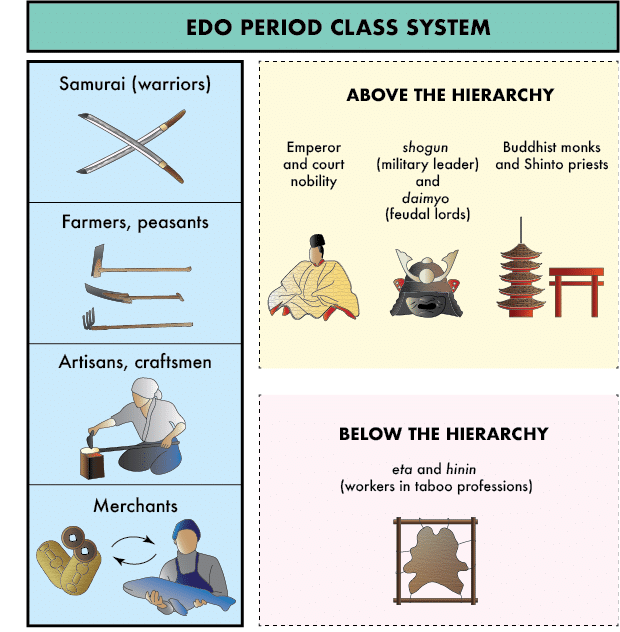
The shifts that occurred within the Edo Period class system played a key role in the growing importance of Osaka during this time. In particular, Osaka grew as a mercantile centre. The peace of the Edo Period meant that although samurai were at the top of the social ladder, their skills as warriors were not being put to use in maintaining order. Meanwhile, merchants and artisans became increasingly wealthy, and so despite being theoretically weak in the social hierarchy, they became powerful as time went on. Osaka was dominated by merchants, in contrast with other cities such as Edo (now Tokyo) and Kyoto, and a great deal of trade passed through Osaka.[13] One distinctive image of the lives of these Edo Period townspeople is their homes, called machiya. Due to their wooden construction, machiya were not durable, and unfortunately this means that very few have survived in Osaka; however, in other cities they have been preserved, especially in Kyoto, where the style was similar. The typical machiya had a long shape with a narrow storefront, allowing many houses to sit alongside one another.[14] Behind the shop area was a small reception and then the home area, with a floor made from tatami straw mats which continue to be used in traditional Japanese-style rooms today. Deeper still into the house, the garden and storehouse could be found; meanwhile, the kitchen would have been located in a dirt-floored hallway that typically ran from the front to the back alongside the other rooms. This elongated layout results in houses that are considerably larger than they appear from the outside, rather fittingly for members of a class who acquired wealth far exceeding their supposed social status.
As this was around the time that the name Osaka came into use, the Edo Period is also when we see some early estimates of its population. Before discussing these estimates, it is worth pointing out some challenges in producing the numbers. First of all, the Japanese Census was first carried out in 1920, meaning that earlier numbers may be less reliable. However, systems such as the koseki household register provide some evidence of how many people lived in different parts of the country during the Edo Period.[15] Another issue is the caste system described above. Although this system separated the living areas of different classes, easing administration, the fact that some groups were excluded means that counts may register only certain sections of the population. Finally, there is a problem of definition: Osaka was officially established as a city in 1889, and as mentioned earlier, many areas that are parts of Osaka today were not originally included. [16] This is complicated further by the fact that in the Edo Period, the land of modern Osaka Prefecture belonged to the three provinces of Settsu, Kawachi and Izumi. As a result of these issues in determining the population of what is now Osaka City, it is important to keep in mind that any numbers before the 20th century are general estimates at best.
Some upper estimates suggest that Osaka’s population during the Edo Period may have been as high as 400,000 to 500,000.[17] It is possible that this is accurate when talking about the area that Osaka City now covers – with Sakai’s population potentially being included as well – but as figures from the late 19th century put the population below this, it is unlikely that Osaka proper had quite this many people, at least until late in the Edo Period.[18] Judging from some of the lower estimates, Osaka’s population increased significantly during the 16th century, when it returned to prominence as the site of Osaka Castle, growing from perhaps 10,000 or 20,000 to well over 100,000.[19] By the mid-17th century, the population was probably at least 200,000, and the city grew further still thereafter, though it stagnated somewhat as the military capital of Edo – Tokyo after the Meiji Restoration of 1868, when it became the country’s official capital city – drew more trade. Industrialisation revived Osaka however, increasing the city’s population many times over during the late 19th century, until it exceeded 1 million by 1908. The 1925 census, where the population rose to over 2 million, even saw Osaka surpass Tokyo. Two factors in this were the incorporation of over 40 nearby towns and villages into Osaka City that year, and a surge in migration of citizens from Tokyo after the widespread destruction impacting the capital in the Great Kanto Earthquake of 1923.[20] Tokyo soon recovered, but Osaka continued to grow, and reached a peak of over 3 million in the 1940 census. However, this did not last, as Osaka’s population plunged during the Second World War, due in part to multiple bombing campaigns. Since then, the population has never quite reached its pre-war highs, and gradually fell for most of the second half of the 20th century, remaining below 3 million apart from a short period in the 1960s.[21] As of the 2015 census, Osaka is Japan’s third-most populous city, after Tokyo and Yokohama, and ahead of Nagoya and Sapporo.[22]
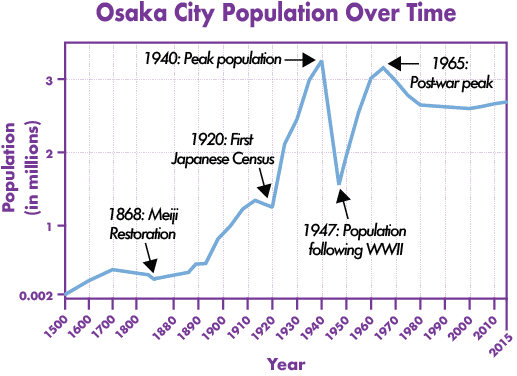
As mentioned above, the Second World War had a dramatic effect on Osaka and its population. No other incident has impacted Osaka’s population so drastically before or since, but Japan is prone to natural disasters due to its geography and climate, and Osaka is no exception. One of Japan’s most devastating earthquakes of modern times, the Great Hanshin Earthquake, occurred in Osaka Bay in 1995, causing over 5000 casualties in neighbouring Hyogo Prefecture.[23] While the death toll in Osaka Prefecture was only 21, the earthquake had a significant impact on infrastructure linking Osaka with Kobe, including roads and railway lines. The most severe earthquake to directly hit Osaka since records began was more recent, in 2018.[24] There were very few casualties, but a great deal of injuries and property damage. Some of Osaka’s most damaging natural disasters have been typhoons: major typhoons in 1934 and 1961 left hundreds dead and caused damage throughout the city and the surrounding area.[25] Disasters other than those caused by geology and weather have also affected Osaka over the years, such as train accidents and fires. Although Osaka has never experienced anything on the scale of the Great Kanto Earthquake of 1923 or the 2011 Tohoku earthquake and tsunami, the possibility of such far-reaching disasters is ever-present, and this affects housing regulations and other aspects of people’s lives.[26] In the same way that machiya-style houses have become rare in Osaka, the experience of disaster, even nearby, plays an important role in determining how and where people live thereafter. If Osaka were to be affected by such a large-scale event one day, the results would surely play a defining role in Osaka’s future growth and development.
Demographic challenges
As of 2019, Osaka City’s official statistics put the population at around 2.74 million, for a population density of over 12,000 per km2.[27] This means the city is considerably more densely populated than the prefecture as a whole, which itself is among the top prefectures in Japan for population density.[28] This is to be expected for a major urban area. Most other statistics related to Osaka are recorded at the prefectural rather than municipal level, and this is also where the most straightforward comparisons can be made with other parts of Japan. For example, Osaka Prefecture has one of the highest minimum wages in Japan, but also some of the highest rates of unemployment and households living on social welfare.[29] Furthermore, despite being one of Japan’s foremost economic centres, the average income is significantly lower than in Tokyo, with the prefecture’s higher-income areas to be found in the north, for example in wealthy Minoh City.[30] Related issues such as homelessness contribute to an often-repeated negative perception of Osaka as more unpleasant and more dangerous than elsewhere in the country. However, this is of course only one example of a problem that affects all of Japan, as well as other countries: an increasing gap between rich and poor, and a growing number of residents living in relative poverty.[31] By looking at the backgrounds behind some distinctive details of Osaka’s demographics, we can gain some perspective on modern issues and how they apply to Osaka.
The first point to look at is perhaps the oldest: burakumin, the “invisible minority” of Japan. This group has its origins in the Edo Period caste system. As described earlier, that system featured four basic classes in a clear hierarchy, with restrictions on mixing; even so, groups lower in the system were ultimately able to improve their standing and undermine the hierarchy by amassing wealth. Beneath the four castes, however, were people who performed work considered “unclean” or otherwise taboo, and as they were separated physically from the rest of society, they did not have the chance to upset the status quo in the way that merchants did. The term buraku (or hisabetsu-buraku) was used after the end of the Edo Period, when the old class system was abolished, to refer to the settlements of these people, who were previously known as eta and hinin.[32] Burakumin refers to residents of these villages, and this is the term mostly commonly used in English, though others exist as well. Despite the abolition of Edo Period classes, discrimination against burakumin continued, forcing them to keep working in abattoirs or other commonly avoided workplaces. As a result, buraku areas remained impoverished, and it was many years before legislation sought to actively improve those districts.[33] The subject became taboo in polite conversation, with place names being changed and controversy arising when historical maps were displayed, but discrimination persisted behind closed doors.
One major incident with regard to burakumin occurred in 1975, when a book began circulating in Osaka which listed locations of buraku and associated family names.[34] This was reportedly used by many major companies to research the backgrounds of potential employees and screen them out. Since then, the issue of having people’s family history investigated has persisted, particularly in the context of potential marriage partners for one’s children. These incidents reveal one of the struggles that these people can face: avoiding traditionally “unclean” jobs does not change their home, and moving home does not change their family background, so the association can be unavoidable. Osaka was the first prefecture in Japan to ban this kind of private investigations, with other prefectures following later.[35] It is no coincidence that this would happen in Osaka, as the issue is generally most significant in western Japan. Indeed, people in Tokyo and other parts of eastern Japan are often unaware of the matter as anything more than an obscure piece of history. Osaka is home to some of the more well-known former outcaste districts, and some public figures famous for their own burakumin background are linked with Osaka, such as former Osaka City Mayor Hashimoto Toru.[36] However, while Osaka has done more than other places to deal with the matter, the depth and extent of the historical discrimination has left longer-lasting marks, such as burakumin entering organised crime.[37] In one notable scandal, the head of the Osaka chapter of a prominent burakumin rights group was revealed to have yakuza connections, leading to further claims that many members were associated with gangs.[38] While understandable when considering the poverty and ostracism experienced by people with a burakumin background, this association with crime contributes to the widespread perception of Osaka as less safe than other parts of the country.
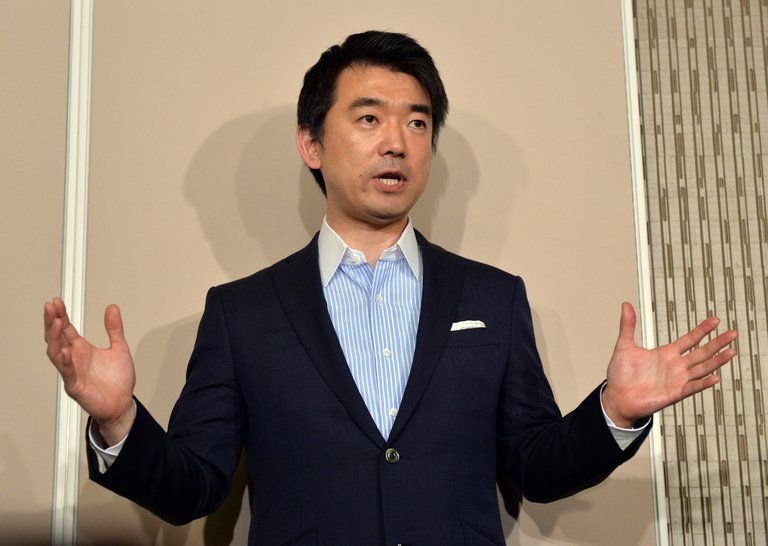
Source: Yahoo News https://sg.news.yahoo.com/comfort-women-cancel-meeting-osaka-mayor-052450103.html
Another facet to Osaka’s unfavourable reputation is the issue of homelessness. Nishinari Ward in southern Osaka City is where one of Japan’s most notorious slum districts can be found.[39] Close to the Shinsekai area – home of Tsutenkaku, a classic symbol of Osaka – a slum called Kamagasaki grew after the completion of Shinsekai in 1912 left many who had worked on the project struggling to gain further employment. It developed more after the destruction of the Second World War, as reconstruction provided opportunities to the day labourers living in Kamagasaki. However, the post-war boom eluded Kamagasaki, and soon highly publicised incidents of unrest drew national attention. The bad reputation led to the area being renamed Airin-chiku, and in official use this has since replaced the old name, which no longer appears on maps. However, there continues to be a significant homeless contingent, mostly of older generations. Recent statistics suggest the number of homeless in Osaka City – and Prefecture – is second only to Tokyo, with numbers remarkably close given that Tokyo’s population is significantly higher.[40] A major part of this issue is Japan’s traditional employment system, which is based on the idea of lifetime employment at a single workplace, where wages increase with seniority.[41] Obviously, day labourers performing hard work for low wages cannot benefit from such a system, resulting in cyclical poverty. This is a problem for increasing numbers of people in Japan, as traditional employment has become less common, and more and more people struggle to make ends meet without a secure salary. This includes “net café refugees”, people working in short-term jobs who cannot afford rent and so sleep in twenty-four-hour internet cafés.[42] Much like burakumin, many homeless people in Japan are those unlucky enough not to have a stable position in mainstream society. Indeed, yakuza groups have a strong presence in the Kamagasaki district, in much the same way as they have provided a place for struggling burakumin.[43] Fortunately, organised crime is weaker in the area than it has been historically, and statistics show a general decrease in homelessness in Osaka and elsewhere in Japan in the last several years, so there is some cause for optimism.
The last aspect of Osaka’s demographics to be explored in this essay is foreign residents. As of 2019, figures show a foreign population of nearly 146,000 in Osaka City.[44] According to nationwide statistics, the only municipality with a higher number is Tokyo.[45] Among Osaka’s foreign residents, there are over 100 different nationalities, including Chinese and Vietnamese, but by far the largest number is those with Korean nationality, at over 60,000. This is in contrast with Japan as a whole, where the most common foreign nationality in recent years is Chinese. Not only are Koreans such a large part of Osaka’s population, but they are also the largest Korean population anywhere in Japan.[46] Many live in Ikuno Ward, making it the ward with the highest percentage of foreign residents in Osaka.[47] Indeed, this percentage is among the highest of any district in the country.[48] Today, the Tsuruhashi area of Ikuno Ward is famous for its Korea Town, boasting many Korean shops and restaurants. A look at the history behind the large number of Korean nationals in Osaka can give us some valuable insight.
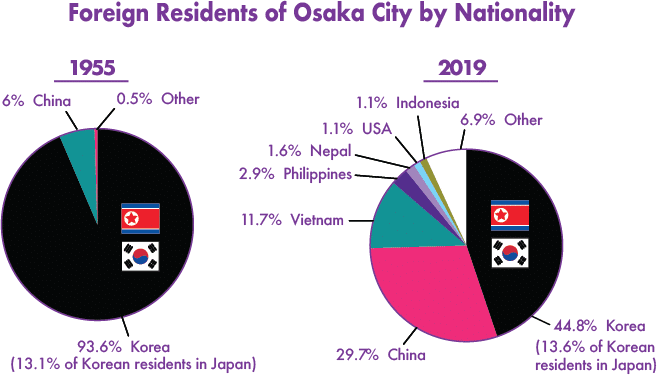
In Osaka’s early history as the port settlement of Naniwa-zu in the 6th to 8th centuries CE, it was a central location for international diplomacy and trade. It has been pointed out that even in these early days, there was a significant foreign population, with traces of Korean-style pottery having been found in the area.[49] In fact, Kongo Gumi, a construction company believed to be the world’s oldest continually operating business, was founded in Osaka by three Korean carpenters in the 6th century.[50] However, the origins of today’s Korean population in Osaka are to be found much more recently. After the annexation of the Korean peninsula by Imperial Japan in 1910, growing industrialisation in Japan led to significant migration of Koreans to Japan.[51] An important development was the beginning of a sailing route directly between Osaka and the Korean island of Jeju in 1923, which brought many factory workers to the area that is now Ikuno Ward. Many more Koreans were forcibly brought to Japan during the Second World War.[52] After the war, great numbers returned to Korea but many stayed in Japan; there were also cases of further migration to Japan, for example thousands of people from Jeju fleeing violence leading up to the Korean War.[53] In the immediate post-war years, the number of Korean residents in Japan was lower than before, but still higher than other nationalities, and over ninety percent of foreign residents in Osaka at the time were Korean.
Since the first migration of Koreans to Japan, they have faced discrimination in many forms. Among other incidents, 1923 saw a massacre of Koreans following false rumours in the wake of the Great Kanto Earthquake.[54] Although this example was an extreme case, life in general could be difficult in those times. Koreans often worked in physically demanding jobs alongside other disadvantaged groups, including burakumin, and poverty was widespread.[55] After the war, another major issue was nationality: their Japanese nationality was revoked, and so, legally speaking, they became foreign residents with either South Korean or Chosen nationality. The latter category was a temporary nationality for all Koreans before Japan established ties with South Korea, and some elected to keep this stateless status rather than become South Koreans; it is thus often erroneously interpreted as North Korean nationality.[56] In either case, the nationality is passed on to children born in Japan, meaning that many Korean “foreign residents” are from families who have lived in Japan for several generations. They are known as zainichi Koreans, which may also include many who have opted to become naturalised Japanese citizens.[57] Because Japan does not recognise dual citizenship, choosing between life as a “foreigner” in what is effectively one’s home country on the one hand, and abandoning the nationality of one’s heritage on the other, is a difficult matter for many zainichi Koreans. Because of their “foreign” status, non-naturalised zainichi Koreans are unable to vote in national elections, and discrimination in housing and employment has continued. They are also a common target of ultra-nationalist hate speech. In much the same way as with burakumin and other people living in poverty, this outsider status means that a significant proportion of yakuza members are of Korean ethnicity.[58]
Discrimination against foreign residents and visitors is unfortunately not uncommon in Japan, and as their numbers increase, so do incidents which inspire backlash.[59] The history of the experiences of Koreans provides many examples of this, but on the other hand, the situation has improved over time. In 2016, Osaka City enacted the first ordinance in Japan to try and tackle hate speech, which was soon followed by a national Hate Speech Act.[60] Osaka was also the first municipality to publicly name perpetrators of hate speech, disclosing the identities of two men who had made repeated anti-Korean comments.[61] These moves, as with others in Japan, have been criticised as insufficient, but after many years of failure to deal with this issue, they are important developments. Furthermore, although the Japanese and South Korean governments continue to have a volatile relationship, citizens’ attitudes towards each other have largely softened, and South Korean television and music enjoys great popularity in Japan today. In Ikuno Ward, the area that was once frequented mostly by Koreans themselves, Korea Town is now a major destination for Japanese people and foreign visitors alike, offering food, cosmetics, merchandise and more.[62] Discrimination against “outsider” groups in Japan sadly remains, and people in those positions often face hurdles in improving their situation. However, people in general are moving away from those attitudes, learning to appreciate different people and cultures, and becoming part of an increasingly diverse community. Apart from ethnic minorities, this includes other disadvantaged groups too: for example, since becoming the eighth municipality to offer same-sex marriage certificates – which are, as yet, not legally recognised nationwide – in 2018, Osaka City has issued more of these certificates than any other district.[63] These developments offer hope for the future, and as a growing destination for tourists and people seeking to live and work in Japan, Osaka is certain to play a key role in that future.
Religion in Osaka
When thinking about the subject of religion in a given country, it is normal to look at how many adherents there are of different faiths. However, this is the first difficulty when discussing religion in the context of Japan. Statistical research on religion in recent years provides similar numbers – around seventy percent of the population – for followers of Buddhism, Shinto, and of no religion at all.[64] This is reflective of the nature of religion in Japan. The tendency is for most people to practise various elements of both Buddhism and Shinto, but without necessarily considering themselves to be devout followers. We can understand this situation better by considering how these religions have developed over time. The aim of this section is to examine the history of Buddhism, Shinto and other religions in Japan, with a focus on the role played by Osaka.
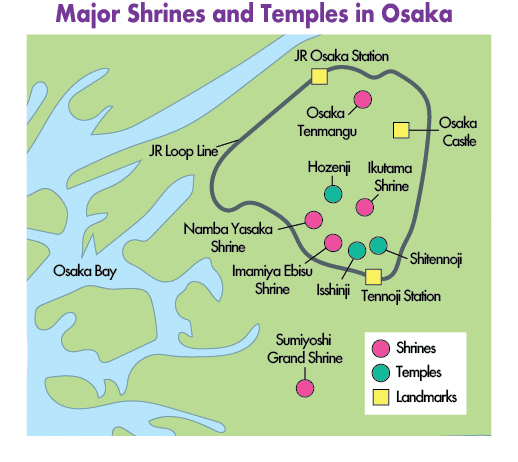
Shinto is generally regarded as the indigenous religion of Japan. For most of history, it was not a particularly organised religion, rather a broad collection of local beliefs, gradually incorporating elements from other Asian religions.[65] Some early examples of these beliefs being tied to political authority can be seen in the construction of kofun burial mounds, including the Mozu-Furuichi mounds in Osaka Prefecture. Shinto myths were later recorded in Japan’s earliest written histories, arguing that the Imperial family were directly descended from the sun goddess Amaterasu, and thus legitimising their rule.[66] Shinto features a vast number of different gods, called kami, which are worshipped at shrines all around the country; however, unlike “gods” in many other cultures, kami can be not only deities but also animals, geographical features and more. For example, the main object of worship of Omiwa Shrine in Nara Prefecture, said to be the oldest extant shrine in Japan, is the mountain on which it stands.[67] The oldest shrine in modern-day Osaka is most likely Ikukunitama Shrine (or Ikutama Shrine), which once stood where Osaka Castle was later built, but was relocated at the time of the castle’s construction by order of Toyotomi Hideyoshi.[68] With over 2000 years of history, it is notable as an example of a unique architectural style called Ikutama-zukuri, and for its connection to cultural traditions including noh theatre and rakugo storytelling.[69] Another important shrine in Osaka’s history is Sumiyoshi Grand Shrine. Built in the 3rd century CE, it is the head shrine of hundreds around the country built to worship the Sumiyoshi Sanjin, three kami said to protect travellers and fishermen.[70] This shrine, too, is famous for its architecture: the Sumiyoshi-zukuri style is one of only three said to predate foreign influences.
Of course, shrines and the religion surrounding them could not remain unaffected by outside influences for ever. Envoys came from Korea, China and beyond, bringing new ideas into Japan, including Buddhism. The traditional date of the introduction of Buddhism in Japan is 552 CE, when an envoy from the Korean kingdom of Paekche brought sacred texts and an image of the Buddha to Emperor Kinmei. The new religion enjoyed popularity among the nobility, and in spite of some false starts, monks continued to visit Japan, and soon the regent Prince Shotoku embraced Buddhism fully. He commissioned the construction of Shitennoji, a temple in what is now Tennoji Ward of Osaka City, by the carpenters that would go on to found the construction company Kongo Gumi. Completed in 593, Shitennoji was the first official Buddhist temple in Japan, kickstarting the introduction of Buddhism as a state religion.[71] The arrival of Buddhism was important to the ruling establishment in other ways as well, as along with it came other Chinese ideas such as Confucian philosophy and the written word.[72] Based on these ideas, Prince Shotoku established new laws and systems, and after his death he was popularly associated with several Buddhist deities.[73] As the centre of political power was in the Nara region at the time, the early Japanese Buddhist traditions were also focused in that area, and when the capital later moved to Kyoto, Buddhist monks followed.[74] Although Osaka was crucial at the beginning of Japanese Buddhism, the focus quickly moved away, and the many sects that developed over time were generally born elsewhere.
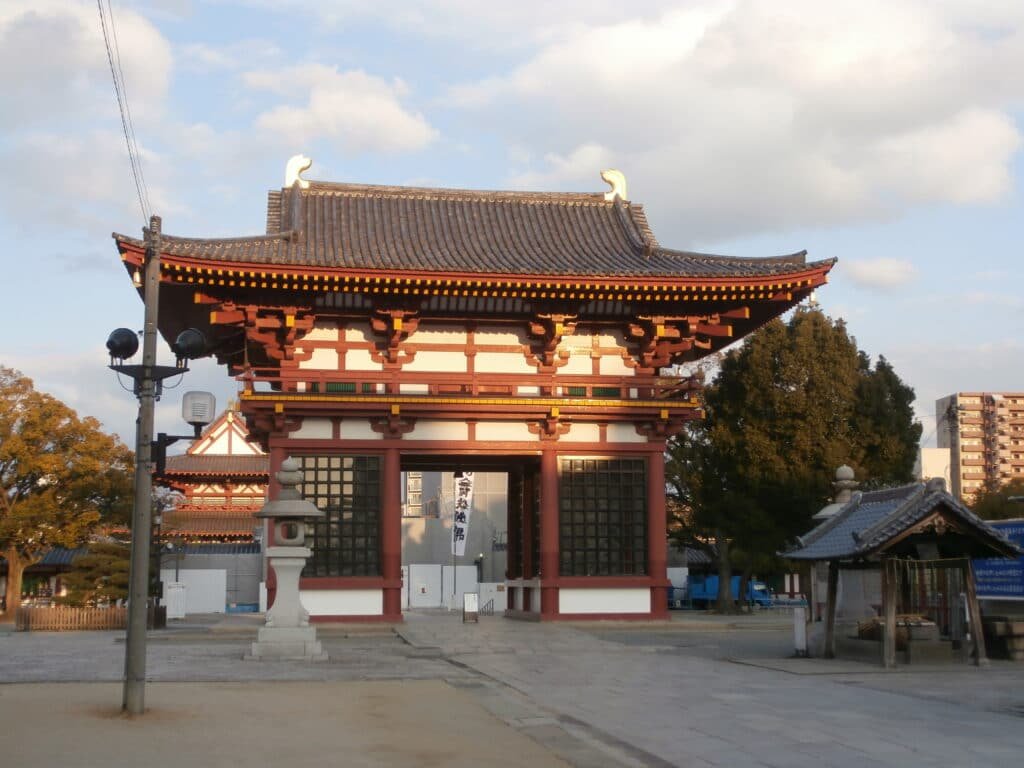
When Buddhism arrived in Japan and became promoted by emperors, active syncretism occurred between it and Shinto. At first, Buddhist deities were recognised as “foreign kami”, which enabled them to coexist conceptually with native gods.[75] At the same time, combining with other beliefs was not necessarily an issue for Buddhism either, as it had already incorporated various outside ideas in India, China and Korea before reaching Japan. As a result, small Shinto shrines were typically added to the grounds of Buddhist temples, and vice versa. There were also various theories attempting to reconcile the different positions of Buddhist and Shinto deities, leading to, for example, the establishment of jinguji (“shrine-temples”) based on the idea that kami, like other sentient beings, must be liberated through Buddhist teachings.[76] It also became common to interpret local kami as representations of Buddhist deities, and sometimes the other way around as well.[77] A significant early example of this fusion of Buddhism and Shinto is the Kumano shrines in modern-day Nara and Wakayama Prefectures.[78] The existing kami of these shrines were viewed as incarnations of Buddhist deities, and soon they became a major destination for pilgrims. Worshippers including emperors and nobles would travel from Kyoto via the Yodo River, arriving at the port town of Watanabe-no-tsu in what is now the Tenmabashi area of Osaka City, before continuing with their pilgrimage to the Kumano shrines, Shitennoji and Sumiyoshi Grand Shrine.[79] The latter was a well-known destination by the Heian Period – when the capital moved to Kyoto – and appears briefly as a location in the Tale of Genji, written in the 11th century and since recognised as perhaps the most important work of classic Japanese literature.[80] Buddhism and Shinto coexisted and were a major part of people’s lives in Japan for hundreds of years, and Osaka was no exception.
However, the syncretic perspective on Buddhism and Shinto later faced growing opposition. The kokugaku school of thought which developed during the Edo Period revolved around a nativist point of view, seeking to extricate a distinctive Japanese tradition from Chinese influences including Buddhism and Confucianism.[81] Those who prescribed to this way of thinking believed that native art, literature and beliefs had become subordinate to imported value systems, and that Japan could prosper through the revival of an ancient Japanese past. During the Edo Period, the sakoku policy isolated Japan by closing the country off to the majority of foreign trade.[82] This allowed kokugaku ideas to develop, but it was Japan’s reopening that enabled them to have a greater influence on policy. 1868 saw an official separation edict, which aimed to distinguish Buddhism from Shinto, and importantly to elevate the status of Shinto. This paved the way for what is now called “State Shinto”, a system which selectively appropriated elements of Shinto and fashioned them into a united ideology to frame state actions as just and opposition as traitorous.[83] Under State Shinto, shrines were organised and ranked in order of importance, with Ise Grand Shrine – traditionally among the most sacred shrines – above all others. Osaka City’s most important shrines in this system were Sumiyoshi Grand Shrine and Ikukunitama Shrine, though many others were also incorporated into the national rankings.[84] After the Second World War, Shinto was subjected to special censure, being perceived as a core element of the nationalism that supported Imperial Japan’s policies. Emperor Hirohito renounced the idea of his divinity that had significantly driven nationalist ideology, and the Shinto Directive of the Allied Occupation banned state support for Shinto. The bureaucracy overseeing shrines nationwide was also dismantled, including the ranking system. Even so, in spite of the dissolution of State Shinto systems, Shinto continues to be a part of people’s lives, and in spite of the attempted separation from Shinto earlier, Buddhism is just as important.
In modern Japan, people regularly participate in both Shinto and Buddhist rituals, to the extent where it can be difficult to tell them apart. Some traditional weddings are Shinto ceremonies, but most funerals are Buddhist rituals.[85] This helps to explain how so many people can feel that they follow both, but it also provides a hint as to why the same proportion may consider themselves not to be religious. Many of these rituals are simply a part of everyday life in Japan, in ways that may not always be obvious.[86] A common example of how these religions play an almost unavoidable role in people’s lives is the many festivals held throughout the year. These local festivals, or matsuri, are generally associated with a Shinto shrine, and some are popular enough to be known throughout the country. Of these, three are generally considered the biggest: Gion Matsuri, the oldest, held in Kyoto, Kanda Myojin Matsuri, in Tokyo, and Tenjin Matsuri, held in and around Osaka Tenmangu shrine.[87] Osaka Tenmangu is one of hundreds of shrines around Japan devoted to the spirit of 9th-century scholar Sugawara no Michizane.[88] He rose through the ranks in the Heian court, but fell afoul of influential figures and ended up exiled to Kyushu, where he eventually died. After a succession of disasters following his death were attributed to his vengeful spirit, shrines were erected and he was recognised as Tenjin, a kami of scholarship. The ceremony of Tenjin Matsuri has its roots in the hokonagashi ritual, held since the year 951, where a ceremonial item is set out into the Dojima river from a boat.[89] The river is central to the festival, as a lengthy procession of dancers, drummers and costumed characters leads to the water, bringing the mikoshi that temporarily transports Tenjin’s spirit on to a boat.[90] The parade continues on the river, with more mikoshi and more boats sailing up and down into the evening. Today, the festival ends – always on 25 July – with a fireworks display. Hundreds come every year to enjoy the procession, the many stalls lining the riverbank, and the fireworks. As a classic example of a Japanese summer festival, Tenjin Matsuri is a clear case of how people can enjoy the excitement and spectacle of originally religious events without paying particular attention to the fairly austere ritual aspects.
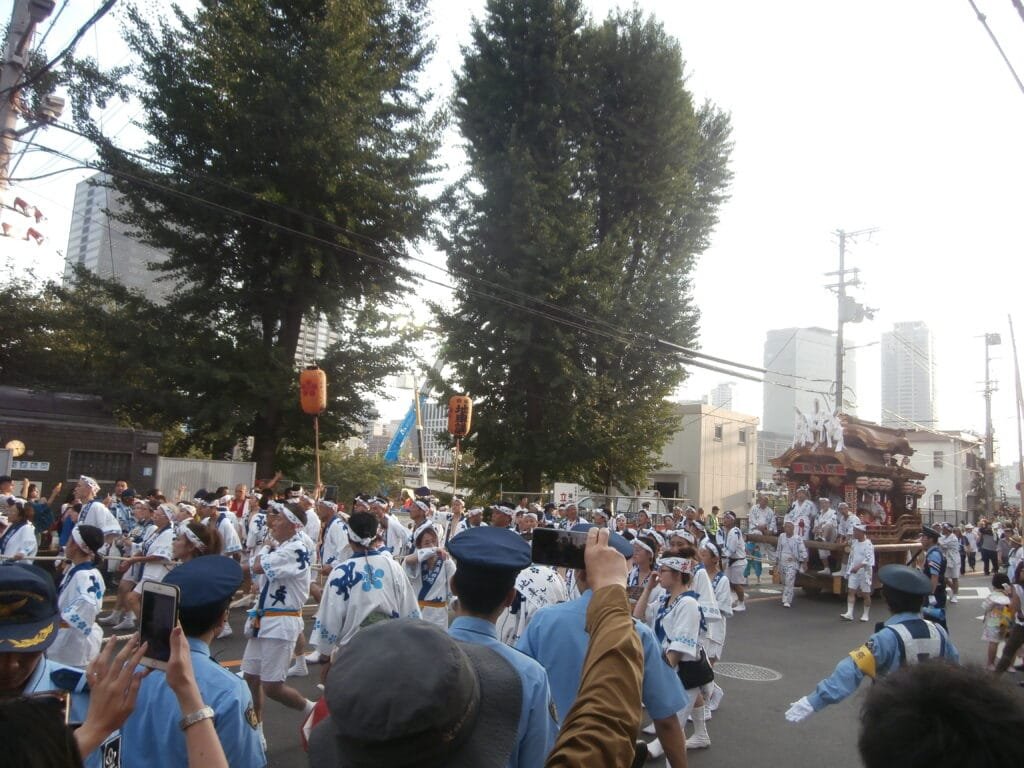
Parades are an important part of Tenjin Matsuri, and this can be seen in many other popular festivals. For example, the Kishiwada Danjiri festival is held every autumn in southern Osaka Prefecture. This festival features danjiri, which are huge, elaborately designed, wooden floats pulled around neighbourhoods.[91] This makes them fairly similar to mikoshi, but importantly, danjiri are wheeled, allowing them to be moved and turned quickly, even with team members standing on top, dancing and playing music. The festival in Kishiwada has a history of over 300 years and is sometimes claimed to be the first of its kind. It is said to have begun in the early 18th century as part of Inari-sai, a festival held to pray for a good harvest.[92] The feudal lord allowed townspeople into the castle grounds to perform with their danjiri, and over the years, this developed into a major annual event for people in the area. Festivalgoers continue to enjoy the excitement of the danjiri parade around the town, which often has a competitive element with teams trying to pull their danjiri fastest and make dramatic turns as quickly and smoothly as possible. Though the Kishiwada festival is the most famous, other danjiri events are held all over Japan, including several other areas of Osaka, particularly in the south.[93] Like Tenjin Matsuri, these are lively events which are steeped in long-standing traditions, but which most attendants do not necessarily enjoy for their religious significance.
On the other hand, the festivals mentioned so far continue to feature ritual components, even if they are not the main draw nowadays. There are also other old festivals which are relatively solemn and still held today, including many at Sumiyoshi Grand Shrine.[94] The shrine has energetic popular festivals like Sumiyoshi Matsuri – one of Osaka’s three great summer festivals, together with Tenjin Matsuri and Aizen Matsuri – but the annual calendar also features a number of ancient ceremonies such as Otaue, where rice seedlings are planted and dances are performed to pray for a rich harvest. These events often feature participants in traditional costumes carrying out complex rituals, and while there may be large crowds of spectators, the party atmosphere of summer festivals and danjiri performances is absent. One interesting regular event at Sumiyoshi Grand Shrine is the monthly Hattatsu Mairi.[95] Based on the traditional calendar derived from the Chinese zodiac system, one day of each month is designated as lucky, especially for business. Businesspeople visit four of the small shrines within Sumiyoshi’s grounds to pray, and buy cat-shaped charms. The popularity of this event is perhaps no surprise given Osaka people’s reputation as shrewd in business. In the same vein, the kami Ebisu has traditionally been popular in Osaka and the surrounding Kansai region.[96] Ebisu, originally a protector of fishermen, came to be known as a lucky god for merchants by the 12th century. Trade has been important throughout Osaka’s history, so it is only natural that Ebisu continues to be popular with locals today, being the focus of the Toka Ebisu festival held every January at Imamiya Ebisu Shrine, as well as other nearby Ebisu shrines in Nishinomiya and Kyoto.[97]

In Japan, Buddhism and Shinto are by far the most common religions, and due to their history, a great number of people may feel affinity with both, but without being a particularly devout adherent of either one. Followers of other religions make up under ten percent of the Japanese population, with the most common of those being Christianity.[98] The percentage of people who identify as Christians is not particularly high in Osaka Prefecture, with several other parts of the country having greater concentrations, but in terms of raw numbers, the number of Christians is among the highest in Japan. The history of Christianity in Japan dates back to the 16th century, when the Navarrese missionary Francis Xavier arrived in Kyushu to spread the religion. He travelled to Kyoto with hopes of persuading the emperor to convert to Christianity, stopping in Sakai on the way, where the 400th anniversary of his visit is commemorated in a park on the estate of a wealthy merchant who welcomed Xavier.[99] However, he soon learnt that the emperor lacked real political power, and in the years that followed, Christianity ended up being outlawed by Toyotomi Hideyoshi.[100] Missionaries were put to death, and throughout the Edo Period, Christians had to practise their faith in secret. After the Meiji Restoration signalled the end of the Edo Period and allowed freedom of religion, Osaka was one of a handful of ports permitted to have a foreign settlement district, together with the more famous settlements in Kobe and Yokohama. Though the Osaka foreign settlement is considered to have been a failure and is rarely discussed, its most notable remains include missionary schools and the Kawaguchi Christ Church Cathedral.[101] Perhaps this history as home to one of the earliest Christian communities since the first missionary attempts, as well as the high foreign population, can help to explain the relative large number of Christians in Osaka today.
While those who regard themselves as Christians may be more likely to have stronger faith than many of the Japanese people who report their religion as Buddhism or Shinto, Christianity also offers examples of how religious events are incorporated into everyday life without concern for their religious significance. As mentioned earlier, funeral ceremonies in Japan are typically Buddhist, while traditional weddings are Shinto ceremonies; however, since the 1990s, traditional Shinto weddings have been outnumbered by Christian weddings.[102] Despite not being Christian themselves, many consider the style of these ceremonies to live up to a romantic ideal in a way that traditional weddings do not, encouraging an industry providing everything from church-style weddings chapels to Westerners acting as “priests”.[103] This trend, in combination with the existing tendency to be involved in both Shinto and Buddhist practices, has led to the idea “Born Shinto, live nonreligious, wed Christian and die Buddhist”. Another curious phenomenon is the mainstream popularity of Christmas in Japan. The holiday is often observed by families as a gift-giving occasion, and Christmas Eve has been promoted particularly as a romantic event to be enjoyed by couples.[104] Christmas lights and other illuminations are common around the country, as well as other events such as Osaka’s annual German Christmas Market.[105] As suggested by the specific aspects of Christmas typically celebrated, this too is largely about spectacle and aesthetics.
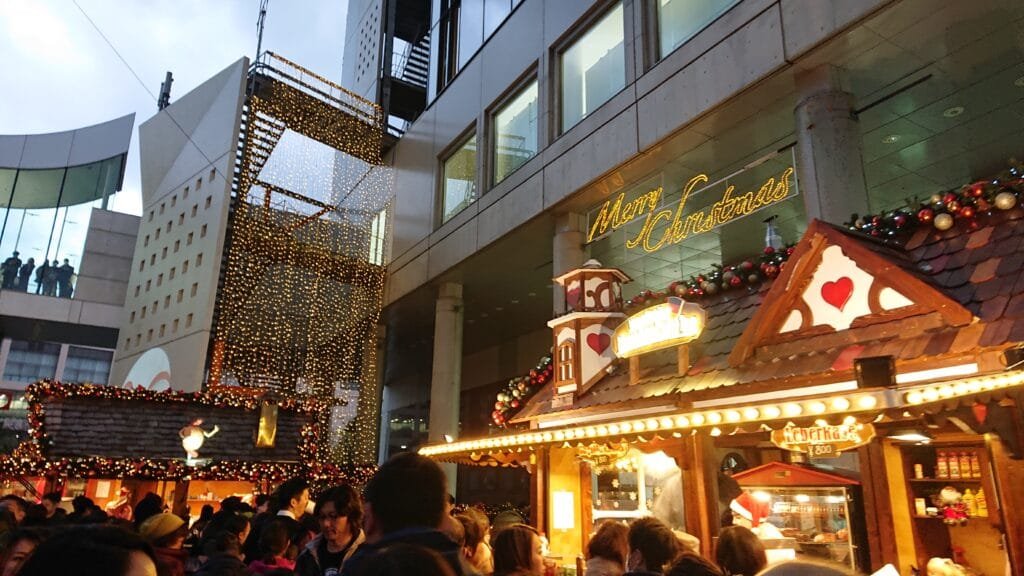
In the context of Japan’s religious history, this syncretic approach to Christianity makes a good deal of sense. Though Christians were persecuted during the Edo Period, in modern Japan Christianity is not seen as necessarily contrary to Japan’s traditional belief systems, and so as with Buddhism and Shinto, even those without much interest in religion may participate eagerly in events. Many Japanese people describe themselves as “nonreligious”, but in practice this entails an appreciation of elements of multiple religions, either native or imported. For this reason, historically significant sites such as Shitennoji and popular celebrations like Tenjin Matsuri are surely here to stay, even if fewer people feel connected to religion in the modern world.
Education in Osaka
As of 2018, Japan has the highest average score for mathematical performance among OECD countries, and the second highest for science performance.[106] Furthermore, the percentage of adults over 25 with tertiary education is among the highest.[107] Education in Japan is under the jurisdiction of the Ministry of Education, Culture, Sports, Science and Technology (MEXT), and the education system is the same across the country.[108] The aim of this section is to describe the education system and its history, and to provide insight into the significance of historical institutions in Osaka for the development of education in Japan today.
Organisation of schools in Osaka Prefecture depends on the education level. While elementary and junior high schools are overseen by each city’s Board of Education, it is the Prefectural Board of Education that has responsibility for high schools and special needs education.[109] There are also various private schools and universities. Compulsory schooling begins at around the age of 6, with six years of elementary school, which is then followed by three years of junior high school.[110] Kindergarten – typically lasting two years – and high school, which is for three more years, are not compulsory, but the vast majority of Japanese people today enrol in both. Education beyond high school comes in several forms, including universities, most of which are privately run. There are several universities in the prefecture which historically had their main campus in Osaka City. These include Kansai University and Osaka University, both of which are now situated in Suita in northern Osaka Prefecture. Generally speaking, national universities are considered the most prestigious in Japan, and Osaka University reflects this, appearing in Japan’s top 10 universities according to several ranking publications.[111]
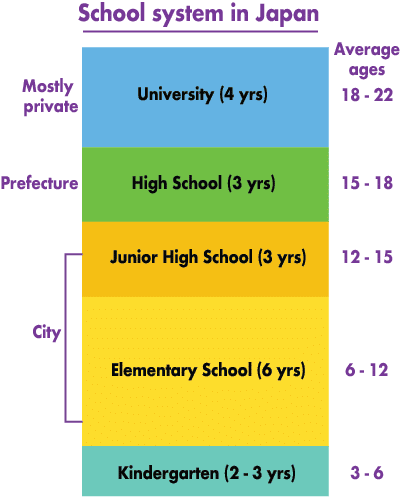
Japan’s standard 6-3-3-4 system (six years in elementary school, three years in junior high school, three years in high school, four years in university) has been in place throughout the post-war period, but this also means that it is a relatively recent development.[112] However, structured education has existed in Japan in other forms since ancient times. Japan’s first university, Daigaku-ryo, was founded in Kyoto in the 7th century CE, as an institution for educating future government officials in the “four great sciences” of Confucian principles, mathematics, history and law.[113] A greater focus on the arts developed during the Heian period, but this continued to be targeted at the aristocracy only.[114] Outside of the imperial court, education mostly took place in Buddhist temples and government-established provincial colleges. These colleges, associated with Daigaku-ryo in Kyoto, were to be found in each province’s administrative capital. Though the evidence is unclear, Watanabe-no-tsu in modern-day central Osaka is believed to have been the capital of Settsu Province, so it is likely that one of these colleges once existed in that area.[115] When political authority was held later by the samurai class, education followed suit, catering to those in power and focusing on the skills relevant to their rule, such as horse riding and use of weaponry. Education would spread more during the Edo Period, when the country was largely at peace and outside influence was restricted. Under the rule of shogun Tokugawa Ieyasu, a national school was developed in Edo for a similar purpose to the earlier Daigaku-ryo, to teach Confucian values to the children and subordinates of those in power, and to serve as a model for other schools around the country.[116] For people of the lower classes, practical training through apprenticeships was typically the most important form of education, but increasingly they attended temple-associated schools called terakoya to learn to read and write, as well as other skills depending on their social position, for example abacus calculation.[117] An example of terakoya remains today at Seigakuin, a temple in Sakai City with a preserved machiya residence.[118] By the end of the Edo Period, these schools largely resembled modern institutions, and welcomed more and more female pupils, who had previously been mostly excluded from formal education.[119] Meanwhile, private schools called shijuku were operated for the purpose of tuition in specialist subjects, becoming the forerunner of juku (also known in English as “cram schools”) today.[120]
So far, the focus has been on lower-level education in the Edo Period, which became more widespread than before and significantly increased literacy among the Japanese population. There were important developments in higher education too, however, and two institutions in Osaka were central to this. First was the Kaitokudo, an academy organised by and for merchants in the early 18th century, which received official recognition from the Edo government in 1726.[121] Crucial to the Kaitokudo’s philosophy was the idea that virtue and the ability to acquire knowledge were human traits, irrespective of social class. This allowed them to develop a rationalistic approach based on scientific learning, and to make vital contributions to intellectual thought of the time. The Kaitokudo remained open until the end of the Edo Period, and though there was a revival in the early 20th century, only the library survived the bombing of Osaka in the Second World War.[122] The books that survived were later donated to the newly-founded Osaka University as a key contribution to its School of Law and Letters. Osaka’s other famous Edo Period institution is Tekijuku, an academy of medicine and rangaku (“Dutch studies” or Western science) founded in 1838 by Ogata Koan.[123] Like the Kaitokudo, Tekijuku was open to all regardless of social background, and the school soon gained an outstanding reputation.[124] While teaching, Koan translated medical and scientific texts from Dutch into Japanese, and worked against diseases ravaging Osaka and the rest of Japan, notably cholera and smallpox. Some of Tekijuku’s most famous alumni include Sano Tsunetami, founder of the Japanese Red Cross Society, and Fukuzawa Yukichi, influential thinker and founder of Keio University, who continues to be commemorated on the 20,000-yen note.[125] Later, Tekijuku was renamed as Osaka Prefectural Medical School, and became Osaka Imperial University in 1931. After the Second World War, more departments were added, and the name was changed once more to Osaka University. Thus, Kaitokudo and Tekijuku both live on today, not only through their influence on the development of higher education throughout Japan, but also together as Osaka’s best-known university.
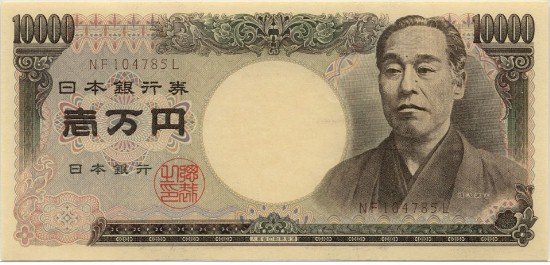
Source: Wikipedia https://en.wikipedia.org/wiki/10,000_yen_note
Other than Osaka University, there are several other universities in Osaka, some of which trace their histories as far back as the 19th century. For example, Kansai University started as Kansai Law School in 1886, as a local counterpart to Tokyo Hogakusha, which itself later became Hosei University.[126] In a similar manner to Osaka University’s relationship with the former Kaitokudo, Kansai University also houses a library collection from Hakuenshoin, a well-regarded shijuku founded in 1825 that flourished alongside Kaitokudo and Tekijuku.[127] The law school was established as Kansai University in 1905, and like many other institutions, it expanded its range of subject areas significantly after the Second World War. Another major university in Osaka is Kindai University, previously known as Kinki University before a decision to change its English name in 2016.[128] It was founded in 1949 as a merger of Osaka Technical College and Osaka Science and Engineering University. In the Kansai Big6 baseball league – which features five other universities including Kansai University – Kindai’s team is the most successful, having won over 40 league championships.[129] Osaka City University also boasts a long history, having its roots in Osaka Commercial Training Institute, a merchant-driven academy founded in 1880, before being established in 1928 by then-mayor of Osaka as Osaka University of Commerce, the first municipal university in the country.[130] Of course, there are also many more universities within Osaka City and elsewhere in the prefecture, especially northern areas, as well as in surrounding prefectures like Kyoto and Hyogo.
According to the 2019 statistics from the Japan Student Services Organisation (JASSO), there are currently over 300,000 international students – those on a “college student” visa studying at higher education or Japanese language institutes – in Japan, a higher number than ever before.[131] The international student population has risen especially rapidly in the 2010s, having been around half of this number just ten years ago. Accepting international students is a somewhat recent phenomenon in Japan, as for much of the Edo Period, the country was closed to outsiders with few exceptions. This changed during Japan’s era of modernisation after the Meiji Restoration, and in 1881, the first international students came to Japan to study at Keio University in Tokyo.[132] Others soon followed, especially from nearby countries, while Japanese people increasingly travelled to Europe and North America to study.[133]
In recent times, as in those early years, most students coming to Japanese universities are from other Asian countries, with Vietnamese students increasing in number particularly quickly. The 2018 statistics show Osaka as the second-most popular destination behind Tokyo, though the Kanto area around Tokyo accounts for around half of all international students in Japan.[134] Osaka University had more international students than any other university in Kansai in 2018, and the second-most in the country for a national university.[135] This reflects Osaka’s status as a bustling economic hub with easy access to the outside world. Another well-known university in Osaka in terms of overseas exchange networks is Kansai Gaidai University, which developed from Tanimoto English school in 1966.[136] The university focuses on foreign language studies, and in the late 1970s was the first Japanese university to establish an overseas campus with the Kansai Gaidai Hawaii College. Though this experiment ultimately did not survive, the university is still going strong, and claims to have the highest number in Japan of students studying abroad.[137] Osaka’s strong position in international exchange is not surprising, considering the city’s historical significance in trade and culture, and the variety of options in education make Osaka appealing outside of the areas of business and tourism. Indeed, given some of the challenges Osaka has faced, such as tension between Korean and other foreign residents and locals, as well as difficulties affecting all of Japan, including population decline, attracting students from other countries may be key to survival in a changing world.
Summary and conclusions
The area where Osaka City now stands has been inhabited for millennia. During that time, it has grown and shrunk, and been the site of commerce, battles and bombings. As the population has grown and demographics shifted, people’s way of life has varied too. In early times, agriculture was central to people’s lives, while the ports of Naniwa-zu and later Watanabe-no-tsu offered important links to the outside world. Early religion developed in the area, especially with the arrival of Buddhism, when Shitennoji was founded as Japan’s first official temple. Though political significance declined after the capital moved from the Nara area to Kyoto, this all changed with some help from Toyotomi Hideyoshi, who built Osaka Castle, introduced a new system of social classes, and set the stage for the long-lasting peace of the Edo Period. In the Edo Period, the rise of Osaka – as it was now known – as an important economic centre went hand-in-hand with the increasing affluence of the merchant class. Osaka’s merchant culture did not only provide wealth and influence, but also resulted in trailblazing academies for education, with egalitarian outlooks that paved the way for a new system. At the same time, however, the Edo Period class structure – specifically, the way that certain groups of people were excluded from it – resulted in social issues which have continued to affect Osaka since. The 20th century was in many ways positive for Osaka, as it emerged as a truly advanced city, but problems of poverty persisted, and new challenges arose regarding the city’s growing foreign population and their place in Japanese society. Furthermore, there were disasters affecting all residents, including typhoons and, most significantly, bombing in the Second World War, from which Osaka recovered to only a limited extent. Today, Osaka is the third-most populous city and among the most densely populated parts of Japan. People are connected to history through long-standing establishments and religious traditions dating back hundreds of years, but the city is also increasingly diverse, and has a strong record of leading the way in handling social issues. Although Osaka has fallen behind Tokyo in certain respects, the future is bright, with an energetic tourism industry and many opportunities for students both domestic and foreign.
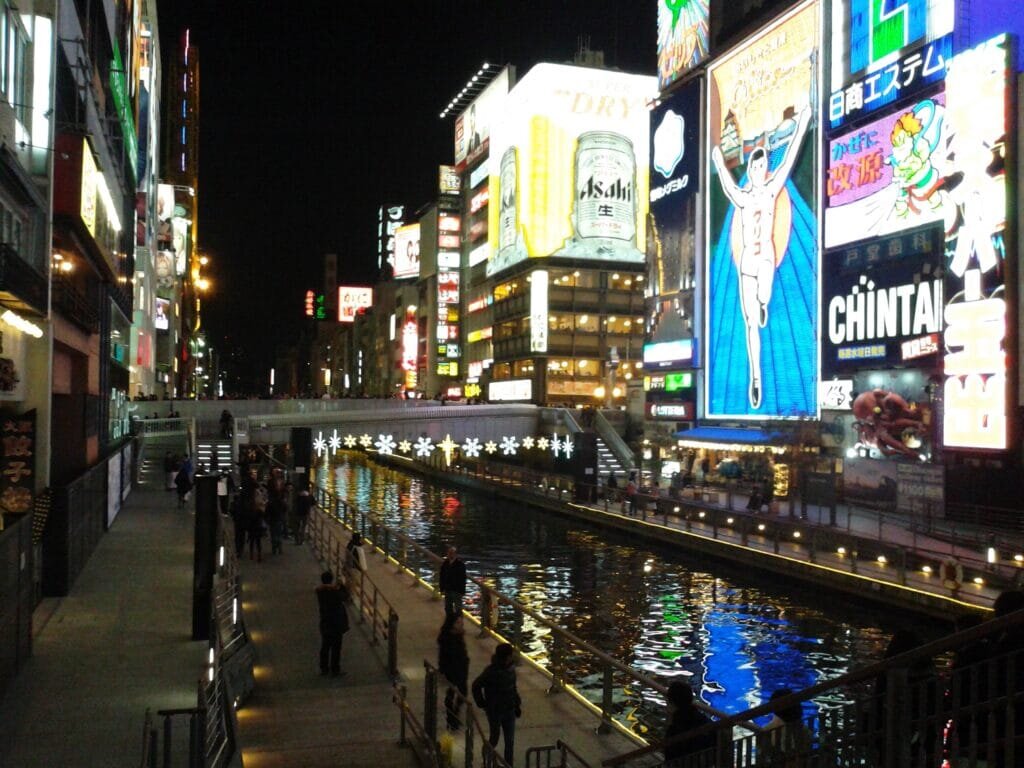
Around Japan, Osaka is often associated with comedy. This is connected to warmth, friendliness and the importance of a good sense of humour, qualities which make up positive images of people from Osaka. It is not unreasonable to attribute this idea in part to the city’s history as a mercantile centre, in contrast with Tokyo, which was dominated in the Edo Period by the samurai ruling class before becoming the official capital and the site of modern government. Though other cities, including Edo, also saw a shift in social dynamics with merchants prospering despite their relatively low standing, Osaka was always a commercial area, and so this change left a more significant imprint on the city’s culture and habits. As a result, Osaka and its people are often perceived as unpretentious. Of course, there are downsides to this as well: there is a stereotype of stinginess, and even an association with danger. The latter is not entirely without reason, but by considering Osaka’s past, it makes some sense. Circumstances resulted in Osaka being home to above-average proportions of social minorities including former outcaste groups and Korean nationals, as well as relatively high levels of poverty. This left many on the margins, putting them in a position for organised crime to take advantage. However, to some extent the idea of Osaka as a dangerous place is overstated, and indeed it has been listed by the Economist Intelligence Unit as one of the world’s most liveable cities – notably, ahead of Tokyo.[138] Ultimately, some of the problems associated with Osaka stem from the same sources as its most positive features: a long history of trade, commerce and social mixing have contributed to some forms of social inequality and a perceived lack of refinement, but also to a great reputation for culture, frankness and good humour.
Except where otherwise noted, graphics are by Rachel Stewart (https://www.rachelstewartphd.com/) and other images are photographs taken by the author.
[1] ‘Profile of Osaka city’. Osaka City official website.
https://www.city.osaka.lg.jp/contents/wdu020/enjoy/en/overview/content_CityProfile.html
[2] Yamamura, H, 2013. ‘In the International Year of Water Cooperation, considering the responsibility for water environment education for the formation of a sustainable society’. Chuo University Online.
https://yab.yomiuri.co.jp/adv/chuo/dy/research/20130404.html
[3] 2019. ‘Beautification of the Yodogawa River Landscape’. Osaka Prefecture official website.
http://www.pref.osaka.lg.jp/attach/34342/00319640/yodogawa_English%20P1-P11.pdf
[4] Keally, C, 2006. ‘Yayoi Culture’. Japanese Archaeology.
http://www.t-net.ne.jp/~keally/yayoi.html
[5] ‘Historical Overview’. Osaka City official website.
https://www.city.osaka.lg.jp/contents/wdu020/enjoy/en/overview/content_Historical_overview.html
[6] Matsumura, K. ‘Kojiki and Nihon shoki (Nihongi)’. Kokugakuin University Encyclopedia of Shinto.
http://k-amc.kokugakuin.ac.jp/DM/detail.do?class_name=col_eos&data_id=23447
[7] ‘Mozu-Furuichi Kofun Group: Mounded Tombs of Ancient Japan’. UNESCO official website.
http://whc.unesco.org/en/list/1593
[8] Kawagoe, A. ‘Daily Life during the Kofun Period’. Heritage of Japan.
[9] Kawagoe, A. ‘Village settlement patterns: the homestead emerges’. Heritage of Japan.
[10] ‘Osaka Campaign’. The Samurai Archives.
https://wiki.samurai-archives.com/index.php?title=Osaka_Campaign
[11] Woods, S. ‘The Three Unifiers of Sengoku Era Japan’. About Japan.
https://aboutjapan.japansociety.org/the-three-unifiers-of-sengoku-era-japan
[12] Szczepanski, K, 2019. ‘The Four-Tiered Class System of Feudal Japan’. ThoughtCo History & Culture.
https://www.thoughtco.com/four-tiered-class-system-feudal-japan-195582
[13] ‘Osaka’. The Samurai Archives.
https://wiki.samurai-archives.com/index.php?title=Osaka
[14] ‘Lecture by Professor Yoshifumi Muneta’. Traditional Kyoto.
https://traditionalkyoto.com/architecture/layout/
[15] Chapman, D, 2011. ‘Geographies of Self and Other: Mapping Japan through the Koseki’. The Asia-Pacific Journal.
‘https://apjjf.org/2011/9/29/David-Chapman/3565/article.html
[16] ‘Historical Overview’. Osaka Convention & Tourism Bureau.
https://osaka-info.jp/en/page/osaka-history
[17] Johnston, E, 2001. ‘The importance of being Osakan’. The Japan Times.
https://www.japantimes.co.jp/community/2001/05/20/general/the-importance-of-being-osakan/
[18] Various sources compiled at ‘Demography of the Empire of Japan’. Wikipedia.
https://en.wikipedia.org/wiki/Demography_of_the_Empire_of_Japan
[19] Various sources compiled at ‘Demographic history of Japan before the Meiji Restoration’. Wikipedia.
https://en.wikipedia.org/wiki/Demographic_history_of_Japan_before_the_Meiji_Restoration
[20] Hashizume, S, 2019. ‘A History of Osaka, Japan’s City of Water’. Nippon.com.
https://www.nippon.com/en/japan-topics/g00681/a-history-of-osaka-japan%E2%80%99s-city-of-water.html
[21] Official Statistics of Japan Census Statistics.
https://www.e-stat.go.jp/stat-search/files?page=1&toukei=00200521&result_page=1
[22] ‘Statistical Handbook of Japan 2019’. Statistics Bureau, Japan.
https://www.stat.go.jp/english/data/handbook/pdf/2019all.pdf#page=23
[23] Miyano, M, et al. ‘Study of casualties due to earthquake disasters and other accidents in Japan’.
https://www.iitk.ac.in/nicee/wcee/article/1029.pdf
[24] Ikeda, T, 2018. ‘Powerful quake that jolted northern Osaka Pref. occurred near fault zone’. Mainichi Japan.
https://mainichi.jp/english/articles/20180618/p2a/00m/0na/015000c
[25] Longshore, D, 2008. Encyclopedia of Hurricanes, Typhoons, and Cyclones. Infobase Publishing.
[26] ‘Earthquake building codes in Japan’. Japan Property Central.
https://japanpropertycentral.com/real-estate-faq/earthquake-building-codes-in-japan/
[27] ‘Osaka City Statistics’. Osaka City official website.
https://www.city.osaka.lg.jp/toshikeikaku/page/0000164533.html
[28] 2018. ‘Population Density’. Statistics Japan.
https://stats-japan.com/t/kiji/13400
[29] Compiled at ‘Osaka’. Statistics Japan.
https://stats-japan.com/t/tdfk/osaka
[30] Mayger, J and Dormido, H, 2017. ‘The Rich Are Getting Richer in Abe’s Japan’. Bloomberg.
https://www.bloomberg.com/graphics/2017-japan-inequality/
[31] Mochida, M, 2019. ‘Japan needs to address its child poverty problem’. Nikkei Asian Review.
https://asia.nikkei.com/Opinion/Japan-needs-to-address-its-child-poverty-problem
[32] Szczepanski, K, 2019. ‘Japan’ Untouchables: The Burakumin’. ThoughtCo History & Culture.
https://www.thoughtco.com/who-are-the-burakumin-195318
[33] Martin, A, 2019. ‘Embracing a buraku heritage: Examining changing attitudes toward a social minority’. The Japan Times.
[34] Fusek, A, 2019. ‘Burakumin: Japan’s Hounded “Untouchables”’. Unseen Japan.
https://unseenjapan.com/japan-burakumin-outcasts/
[35] 2018. ‘Burakumin (Buraku People)’. Minority Rights.
https://minorityrights.org/minorities/burakumin-buraku-people/
[36] Johnston, E, 2012. ‘Hashimoto likes weekly’s slur to hate speak’. The Japan Times.
https://www.japantimes.co.jp/news/2012/11/03/national/hashimoto-likens-weeklys-slur-to-hate-speak/
[37] Gates, J, 2018. ‘Who Are the Burakumin, Japan’s “Untouchables”?’. Culture Trip.
https://theculturetrip.com/asia/japan/articles/a-look-at-the-burakumin-japans-untouchables/
[38] Johnston, E, 2006. ‘Osaka activist’s arrest lays bare yakuza ties with “burakumin”’. The Japan Times.
[39] Schonherr, J. ‘Kamagasaki’. Japan Visitor.
https://www.japanvisitor.com/osaka/kamagasaki
[40] 2018. ‘Homeless Situation National Survey’. Ministry of Health, Labour and Welfare.
https://www.mhlw.go.jp/content/12003000/000330962.pdf
[41] ‘Lifetime Employment’. Cross Currents.
[42] Boggan, S, 2007. ‘Tokyo dreaming’. The Guardian.
https://www.theguardian.com/world/2007/sep/28/japan.socialexclusion
[43] Suzuki, M, 2014. ‘Nishinari’. Tofugu.
https://www.tofugu.com/japan/nishinari/
[44] ‘Changes in Osaka City’s foreign resident population’. Osaka City official website.
https://www.city.osaka.lg.jp/shimin/cmsfiles/contents/0000431/431477/gaikokusuii2019.pdf
[45] Official Statistics of Japan Foreign Resident Statistics.
[46] 2019. ‘South and North Korean Residents in Japan’. Statistics Japan.
https://stats-japan.com/t/kiji/11618
[47] 2018. ‘Where are the most popular places for foreigners to live in Osaka?’ Real Estate Japan.
[48] Okada, Y, 2018. ‘Japan’s foreign population hitting a record high’. Mizuho Research Institute Ltd.
https://www.mizuho-ri.co.jp/publication/research/pdf/eo/MEA180913.pdf
[49] Sakaehara, T, 2008. ‘The port of Osaka: From ancient times to today’. In: Graf, A and Huat, CB, ed. Port Cities in Asia and Europe. Routledge.
[50] 2006. ‘World’s oldest company, started by Koreans, goes kaput’. Hankyoreh.
http://www.hani.co.kr/arti/english_edition/e_international/148711.html
[51] Mun, G, 2009. ‘Origins of the Current Problems of Korean Residents in Japan’. Kyoto Bulletin of Islamic Area Studies.
https://kias.asafas.kyoto-u.ac.jp/1st_period/contents/pdf/kb3_1/13mun.pdf
[52] Johnston, E, 2015. ‘A legacy of WWII, Korean residents test nation’s ability to accommodate non-Japanese’. The Japan Times.
[53] Heo, H, 2018. ‘The April 3 Exodus’. Hankyoreh.
http://english.hani.co.kr/arti/english_edition/e_national/837750.html
[54] Cho, K, 2017. ‘A play teaching the history of the Great Kanto Earthquake massacres to Japanese youth’. Hankyoreh.
http://english.hani.co.kr/arti/english_edition/e_international/797581.html
[55] Moon, R, 2010. ‘Koreans in Japan’. Stanford Program on International and Cross-Cultural Education.
https://spice.fsi.stanford.edu/docs/koreans_in_japan
[56] Park, J, 2018. ‘Koreans living in Japan without nationality’. The Korea Times.
https://www.koreatimes.co.kr/www/nation/2018/06/103_250233.html
[57] Jang, H, 2019. ‘The Special Permanent Residents in Japan: Zainichi Korean’. The Yale Review of International Studies.
http://yris.yira.org/comments/2873
[58] Newsham, G, 2018. ‘Is Japanese organized crime a sunset industry? Don’t bet on it’. Asia Times.
https://asiatimes.com/2018/04/japanese-organized-crime-sunset-industry-dont-bet/
[59] Schreiber, M, 2019. ‘Friction growing in Osaka over rising foreign population’. The Japan Times.
[60] Higashikawa, K, 2018. ‘Japan’s Hate Speech Laws: Translations of the Osaka City Ordinance and the National Act to Curb Hate Speech in Japan’. University of Hawaii.
http://blog.hawaii.edu/aplpj/files/2018/01/APLPJ_19.1_Higashikawa.pdf
[61] Honda, Y and Hanafusa, A, 2019. ‘Osaka publicly discloses names of hate speech perpetrators’. The Asahi Shimbun.
http://www.asahi.com/ajw/articles/AJ201912280019.html
[62] Kin, Y, 2018. ‘Scenes of Heisei: Food serves as political bridge in Osaka’s busting Koreatown’. Mainichi Japan.
https://mainichi.jp/english/articles/20181024/p2a/00m/0na/005000c
[63] 2020. ‘Japan cities recognize 900 LGBT couples since 2015: survey’. Kyodo News.
[64] Iwai, N, 2017. ‘Measuring religion in Japan: ISM, NHK and JGSS’. Pew Research Centre.
https://www.pewresearch.org/wp-content/uploads/sites/7/2017/11/Religion20171117.pdf
[65] Theodore de Bary, W, et al, 2010. Sources of Japanese Tradition: From Earliest Times to 1600. Columbia University Press.
https://www.vlebooks.com/Vleweb/Product/Index/826448
[66] Matsumoto, N, 2019. ‘Amaterasu: The Japanese Sun Goddess’. Nippon.com.
https://www.nippon.com/en/japan-topics/g00748/amaterasu-the-japanese-sun-goddess.html
[67] Omiwa Shrine official website.
[68] Tsubaki, N, 2018. ‘Oldest in Osaka: Ikukunitama Shrine’. Tsubaki no Mori.
https://tsubakinomori193.amebaownd.com/posts/4154244/
[69] Ikukunitama Shrine introduction at Walker Plus.
https://www.walkerplus.com/spot/ar0727s30565/
[70] ‘Sumiyoshi Taisha’. Japan Guide.
https://www.japan-guide.com/e/e4007.html
[71] G.L.M., 2015. ‘Shitennoji Temple’. Japan Experience.
https://www.japan-experience.com/city-osaka/shitennoji-temple
[72] Taylor, I and Taylor, MM, 1995. Writing and Literacy in Chinese, Korean and Japanese. John Benjamins Publishing.
https://books.google.co.jp/books?id=XW9IAAAAQBAJ&printsec=frontcover#v=onepage&q&f=false
[73] Schumacher, M. ‘Shotoku Taishi’. Japanese Buddhist Statuary.
http://www.onmarkproductions.com/html/shotoku-taishi.html
[74] Schumacher, M. ‘Early Japanese Buddhism’. Japanese Buddhist Statuary.
http://www.onmarkproductions.com/html/early-japanese-buddhism.html
[75] Yonei, T and Sato, M, 2005. ‘Combinatory Kami’. Kokugakuin University Encyclopedia of Shinto.
http://eos.kokugakuin.ac.jp/modules/xwords/entry.php?entryID=190
[76] Sato, M, 2006. ‘Shinto and Buddhism’. Kokugakuin University Encyclopedia of Shinto.
http://eos.kokugakuin.ac.jp/modules/xwords/entry.php?entryID=826
[77] Sato, M, 2007. ‘Honjisuijakusetsu’. Kokugakuin University Encyclopedia of Shinto.
http://eos.kokugakuin.ac.jp/modules/xwords/entry.php?entryID=1356
[78] ‘Kumano Sanzan’. Wakayama Prefecture official website (archive).
[79] ‘Watanabe no Tsu (Watanabe Port)’. Japanese Wiki Corpus.
https://japanese-wiki-corpus.github.io/geographical/Watanabe%20no%20Tsu%20(Watanabe%20Port).html
[80] ‘Sumiyoshi Shrine, Osaka’. Tale of Genji.org.
http://www.taleofgenji.org/sumiyoshi.html
[81] Fujiwara, G and Nosco, P, 2018. ‘The Kokugaku (Native Studies) School’. The Stanford Encyclopedia of Philosophy.
https://plato.stanford.edu/entries/kokugaku-school/
[82] ‘Sakoku (Closure of Country)’. National Graduate Institute for Policy Studies.
https://www.grips.ac.jp/teacher/oono/hp/docu03/sakoku.pdf
[83] Theodore de Bary, W, et al, 2010. Sources of Japanese Tradition: 1600 to 2000. Columbia University Press.
https://www.vlebooks.com/Vleweb/Product/Index/826449
[84] Sakamoto, K, 2007. ‘Modern shrine ranking system’. Kokugakuin University Encyclopedia of Shinto.
http://eos.kokugakuin.ac.jp/modules/xwords/entry.php?entryID=1092
[85] Watts Barton, D, 2016. ‘Buddhism and Shinto: The Two Pillars of Japanese Culture’. Japanology.org.
https://japanology.org/2016/06/buddhism-and-shinto-the-two-pillars-of-japanese-culture/
[86] Tamashige, S, 2013. ‘Seeing where Shinto and Buddhism cross’. The Japan Times.
https://www.japantimes.co.jp/culture/2013/05/16/arts/seeing-where-shinto-and-buddhism-cross/
[87] Aoyagi, K, 1983, ‘Viable traditions in urban Japan: matsuri and chonaikai’. In: Ansari, G and Nas, P, ed. Town-Talk: The Dynamics of Urban Anthropology. Brill Publishers.
https://books.google.co.jp/books?id=RQ4VAAAAIAAJ&printsec=frontcover#v=onepage&q&f=false
[88] Wiren, A. ‘Tenjin Matsuri (Tenjin Festival) Osaka’. Japan Visitor.
https://www.japanvisitor.com/japanese-festivals/tenjin-matsuri
[89] ‘Tenjin Matsuri History’. Tenjin Matsuri official website.
https://www.tenjinmatsuri.com/other/history#
[90] ‘Tenjin Festival (Tenjin Matsuri)’. Japan Guide.
https://www.japan-guide.com/e/e4023.html
[91] Bridges, M, 2016. ‘Kishiwada Danjiri Matsuri’. Life in Kansai.
http://lifeinkansai.com/kishiwada-danjiri-matsuri/
[92] ‘Kishiwada Danjiri Float Festival’. International Friendship Association of Kishiwada.
https://ifa-kishiwada.rinku.org/wp-content/uploads/sites/3/2019/09/DanjiriMap_English2019.pdf
[93] 2017. ‘Osaka’s Danjiri Festivals: Beyond Kishiwada’. Kansai Odyssey.
http://kansai-odyssey.com/osakas-danjiri-festivals-a-closeup/
[94] ‘Rituals and Ceremonies’. Sumiyoshi Grand Shrine official website.
http://www.sumiyoshitaisha.net/en/rituals.html
[95] 2017. ‘Hattatsu Mairi: Sumiyoshi Taisha’s Good Luck Festival’. Kansai Odyssey.
http://kansai-odyssey.com/sumiyoshi-taisha-part-2-hattatsu-mairi/
[96] Picken, S, 1994. Essentials of Shinto: An Analytical Guide to Principle Teachings. Greenwood Press.
https://books.google.co.jp/books?id=yA3_QqC6pPgC&printsec=frontcover#v=onepage&q&f=false
[97] 2013. ‘Toka Ebisu Festival in Kyoto’. Sanyo Chemical.
http://www.sanyo-chemical.co.jp/eng/wp/wp-content/uploads/2020/01/kyo_e_201301.pdf
[98] 2019. Agency for Cultural Affairs Religion Yearbook.
[99] ‘Parks’. Sakai City official website.
https://www.city.sakai.lg.jp/smph/english/visitors/enjoying/sightseeing/parks.html
[100] 2015. ‘Saint Francis Xavier and the Roots of Christianity in Japan’. Nippon.com.
https://www.nippon.com/en/features/c02303/
[101] Johnston, E, 2017. ‘Lessons learned from the failure of the Osaka Foreign Settlement’. The Japan Times.
[102] LeFebvre, J, 2015. ‘Christian Wedding Ceremonies: “Nonreligiousness” in Contemporary Japan’. Nanzan Institute for Religion and Culture.
https://nirc.nanzan-u.ac.jp/nfile/4454
[103] Hueston, D, 2017. ‘Christian-style weddings remain popular in Japan, but allure is more about optics than religion’. The Japan Times.
[104] 2015. ‘Christmas in Japan’. Nippon.com.
https://www.nippon.com/en/features/jg00099/
[105] Naho_B_M, 2020. ‘Best Winter Illumination Spots in Osaka 2019-2020’. JW Web Magazine.
https://jw-webmagazine.com/best-winter-illumination-spots-in-osaka-d19f1d509a4e/
[106] OECD ‘Mathematics performance (PISA)’ data.
https://data.oecd.org/pisa/mathematics-performance-pisa.htm#indicator-chart
[107] OECD ‘Population with tertiary education’ data.
https://data.oecd.org/eduatt/population-with-tertiary-education.htm
[108] ‘Chronology of the Ministry of Education, Culture, Sports, Science and Technology (MEXT)’. MEXT official website.
https://www.mext.go.jp/en/about/mext/index.htm
[109] Osaka Prefectural Board of Education official website.
http://www.pref.osaka.lg.jp/kyoikusomu/english/english-1.html
[110] Osaka City Board of Education official website.
https://www.city.osaka.lg.jp/contents/wdu020/kyoiku/english/sinsei/chart.html
[111] QS Japan University Rankings 2019.
https://www.topuniversities.com/university-rankings/rankings-by-location/japan/2019
[112] ‘The Enactment of the School Education Law’. MEXT official website.
https://www.mext.go.jp/b_menu/hakusho/html/others/detail/1317423.htm
[113] Frédéric, L, 2002. Japan Encyclopedia. Harvard University Press.
https://books.google.co.jp/books?id=p2QnPijAEmEC&printsec=frontcover#v=onepage&q&f=false
[114] ‘Japan’. StateUniversity.com Education Encyclopedia.
https://education.stateuniversity.com/pages/736/Japan-HISTORY-BACKGROUND.html
[115] ‘Settsu no kuni’. Provincial capitals blog.
http://komatsu0513.heteml.jp/settsu.html
[116] ‘Education within Samurai Families’. MEXT official website.
https://www.mext.go.jp/b_menu/hakusho/html/others/detail/1317226.htm
[117] ‘Education for Commoners’. MEXT official website.
https://www.mext.go.jp/b_menu/hakusho/html/others/detail/1317227.htm
[118] ‘Sakai Municipal Machiya Historical Museum Seigakuin’. Sakai tourism & convention guide.
https://www.sakai-tcb.or.jp/en/spot/detail/409
[119] ‘Girls’ Education’. MEXT official website.
https://www.mext.go.jp/b_menu/hakusho/html/others/detail/1317228.htm
[120] ‘The Development of Private Schools’. MEXT official website.
https://www.mext.go.jp/b_menu/hakusho/html/others/detail/1317230.htm
[121] Kinzley, W, 1988. Review of Najita, T. Visions of Virtue in Tokugawa Japan: The Kaitokudo Merchant Academy of Osaka.
https://www.jstor.org/stable/368288?seq=1#metadata_info_tab_contents
[122] Kaitokudo Commemoration Society.
http://www.let.osaka-u.ac.jp/kaitokudo/en/index.html
[123] ‘Tekijuku’. Osaka University official website.
https://www.osaka-u.ac.jp/en/guide/about/tekijuku/index.html
[124] Najita, T, ‘Ambiguous Encounters: Ogata Koan and International Studies in Late Tokugawa Osaka’. In: McClain, J and Wakita, O, ed. 1999. Osaka, The Merchants’ Capital of Early Modern Japan. Cornell University Press.
https://books.google.co.jp/books?id=yb0rftAN3oQC&printsec=frontcover#v=onepage&q&f=false
[125] ‘History of Osaka University’. Osaka University official website.
https://www.osaka-u.ac.jp/en/guide/about/history.html
[126] ‘History of Kansai University’. Kansai University official website.
http://www.kansai-u.ac.jp/English/about_ku/history.html
[127] ‘The site of Hakuenshoin’. Osaka City official website.
https://www.city.osaka.lg.jp/contents/wdu020/kensetsu/english/rekishi/uekita/p38e.htm
[128] ‘Traditions & History’. Kindai University official website.
https://www.kindai.ac.jp/english/about/history/
[129] Kansai Big6 baseball league official website.
[130] ‘History’. Osaka City University official website.
https://www.osaka-cu.ac.jp/en/about/history
[131] 2020. ‘International Students in Japan 2019’. JASSO.
[132] ‘About Keio University’. Keio University Law School official website.
https://www.ls.keio.ac.jp/en/about/keio.html
[133] Maruyama, H, 2011. ‘International Student Policy of Japan’. National Institute for Educational Policy Research.
https://www.nier.go.jp/English/educationjapan/pdf/201203IntlSt.pdf
[134] ‘The Current Situation of Accepting International Students in Higher Education Institutions (As of May 1, 2018)’. JASSO.
[135] ‘The Major Universities in terms of Accepting Highest Number of International Student (As of May 1, 2018)’. JASSO.
https://www.jasso.go.jp/en/about/statistics/intl_student_e/2018/ref18_02.html
[136] ‘History’. Kansai Gaidai University official website.
http://www.kansaigaidai.ac.jp/en/info/history/detail/
[137] ‘Facts and Rankings’. Kansai Gaidai University official website.
http://www.kansaigaidai.ac.jp/en/info/fact/detail/
[138] Inoue, Y, 2019. ‘Osaka: Beyond Stereotypes’. Nippon.com.
https://www.nippon.com/en/japan-topics/g00612/osaka-beyond-stereotypes.html




















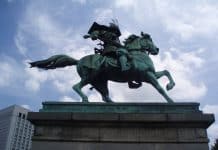
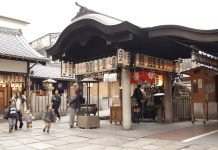
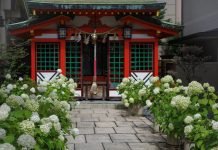





What’s the best way to experience a traditional Japanese ryokan stay?